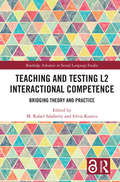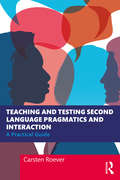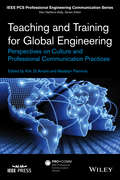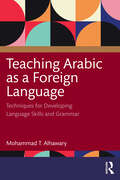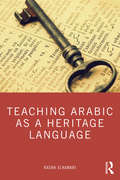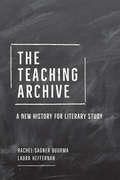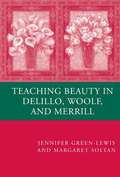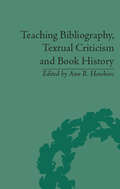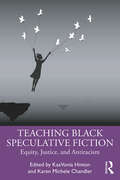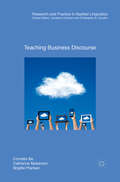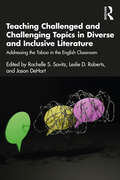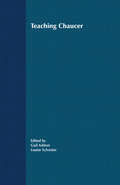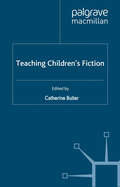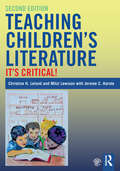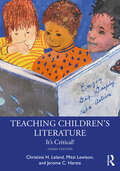- Table View
- List View
Teaching and Testing L2 Interactional Competence: Bridging Theory and Practice (Routledge Advances in Second Language Studies)
by M. Rafael Salaberry Silvia KunitzThis volume features the latest research findings on L2 interactional competence to demonstrate the potential for developing and implementing research-based pedagogy that targets interactional competence (IC) in early instruction in a variety of L2 learning and teaching contexts. Incorporating contributions from both leading and emerging researchers in the area, the book is organized into four sections to provide a systematic account of interactional competence, defined as a set of skills required to co-construct an effective interaction with a variety of interlocutors in a variety of settings, and advocates for IC to be part of a well-rounded curriculum of L2 instruction. The volume provides a comprehensive overview of the different theoretical perspectives on IC within Conversation Analysis, and moves into a discussion of conversation-analytic research findings from a variety of contexts and of their pedagogical implications.The book then presents examples of pedagogy in practice and also illustrates the potential for implementing IC in testing settings. This volume makes a valuable contribution to the growing literature on interactional competence and will be of particular interest to graduate students and researchers in applied linguistics, SLA, language education, curriculum and instruction studies, and educational linguistics. Chapter 13 of this book is freely available as a downloadable Open Access PDF under a Creative Commons Attribution-Non Commercial-No Derivatives 4.0 license: https://tandfbis.s3-us-west-2.amazonaws.com/rt-files/docs/Open+Access+Chapters/9781138038998_oachapter13.pdf
Teaching and Testing Second Language Pragmatics and Interaction: A Practical Guide
by Carsten RoeverPragmatic ability is crucial for second language learners to communicate appropriately and effectively; however, pragmatics is underemphasized in language teaching and testing. This book remedies that situation by connecting theory, empirical research, and practical curricular suggestions on pragmatics for learners of different proficiency levels: It surveys the field comprehensively and, with useful tasks and activities, offers rich guidance for teaching and testing L2 pragmatics. Mainly referring to pragmatics of English and with relevant examples from multiple languages, it is an invaluable resource for practicing teachers, graduate students, and researchers in language pedagogy and assessment.
Teaching and Testing Second Language Pragmatics and Interaction: A Practical Guide
by Carsten RoeverPragmatic ability is crucial for second language learners to communicate appropriately and effectively; however, pragmatics is underemphasized in language teaching and testing. This book remedies that situation by connecting theory, empirical research, and practical curricular suggestions on pragmatics for learners of different proficiency levels: It surveys the field comprehensively and, with useful tasks and activities, offers rich guidance for teaching and testing L2 pragmatics. Mainly referring to pragmatics of English and with relevant examples from multiple languages, it is an invaluable resource for practicing teachers, graduate students, and researchers in language pedagogy and assessment.
Teaching and Training for Global Engineering: Perspectives on Culture and Professional Communication Practices (IEEE PCS Professional Engineering Communication Series)
by Kirk St. Amant Madelyn FlammiaProvides a foundation for understanding a range of linguistic, cultural, and technological factors to effectively practice international communication in a variety of professional communication arenas An in-depth analysis of how cultural factors influence translation, document design, and visual communication A review of approaches for addressing the issue of international communication in a range of classes and training sessions A summary of strategies for engaging in effective e-learning in international contexts A synopsis of how to incorporate emerging media into international teaching and training practices
Teaching and Training for Global Engineering: Perspectives on Culture and Professional Communication Practices (IEEE PCS Professional Engineering Communication Series)
by Kirk St. Amant Madelyn FlammiaProvides a foundation for understanding a range of linguistic, cultural, and technological factors to effectively practice international communication in a variety of professional communication arenas An in-depth analysis of how cultural factors influence translation, document design, and visual communication A review of approaches for addressing the issue of international communication in a range of classes and training sessions A summary of strategies for engaging in effective e-learning in international contexts A synopsis of how to incorporate emerging media into international teaching and training practices
Teaching Arabic as a Foreign Language: Techniques for Developing Language Skills and Grammar
by Mohammad T. AlhawaryTeaching Arabic as a Foreign Language: Techniques for Developing Language Skills and Grammar is an indispensable guide for in-training and novice teachers of Arabic as a foreign language and a source of fresh and effective ideas for experienced teachers. This highly practical guide outlines how Arabic second-language skills (listening, speaking, reading, and writing) and grammar are targeted in isolation from one another and how they are integrated to reinforce each other through the use of specific tried-and-tested techniques and activities. Teaching Arabic as a Foreign Language provides instantly accessible, practical teaching techniques to target and develop specific language skills and grammar at novice, intermediate, and advanced levels.
Teaching Arabic as a Foreign Language: Techniques for Developing Language Skills and Grammar
by Mohammad T. AlhawaryTeaching Arabic as a Foreign Language: Techniques for Developing Language Skills and Grammar is an indispensable guide for in-training and novice teachers of Arabic as a foreign language and a source of fresh and effective ideas for experienced teachers. This highly practical guide outlines how Arabic second-language skills (listening, speaking, reading, and writing) and grammar are targeted in isolation from one another and how they are integrated to reinforce each other through the use of specific tried-and-tested techniques and activities. Teaching Arabic as a Foreign Language provides instantly accessible, practical teaching techniques to target and develop specific language skills and grammar at novice, intermediate, and advanced levels.
Teaching Arabic as a Heritage Language
by Rasha ElHawariTeaching Arabic as a Heritage Language is a practical guide to Arabic pedagogy for Heritage Learners of Arabic. Exploring the teaching of Arabic as a foreign language (TAFL) in North America and Europe, it covers sociocultural topics such as diglossia and religion alongside theoretical approaches to Heritage Language Learning. It also provides a new and detailed definition of the heritage language learner (HLL) of Arabic. The role of the professor and the material are explored to ensure a successful learning experience. The latest advances in HLL are considered together with the recent and recommended changes in classroom practice, giving rise to the recognition of the individual needs of heritage learners. This is an indispensable resource for instructors, researchers, and students in the fields of TAFL and TASOL, as well as linguists interested in Arabic language learning and teaching.
Teaching Arabic as a Heritage Language
by Rasha ElHawariTeaching Arabic as a Heritage Language is a practical guide to Arabic pedagogy for Heritage Learners of Arabic. Exploring the teaching of Arabic as a foreign language (TAFL) in North America and Europe, it covers sociocultural topics such as diglossia and religion alongside theoretical approaches to Heritage Language Learning. It also provides a new and detailed definition of the heritage language learner (HLL) of Arabic. The role of the professor and the material are explored to ensure a successful learning experience. The latest advances in HLL are considered together with the recent and recommended changes in classroom practice, giving rise to the recognition of the individual needs of heritage learners. This is an indispensable resource for instructors, researchers, and students in the fields of TAFL and TASOL, as well as linguists interested in Arabic language learning and teaching.
The Teaching Archive: A New History for Literary Study
by Rachel Sagner Buurma Laura HeffernanThe Teaching Archive shows us a series of major literary thinkers in a place we seldom remember them inhabiting: the classroom. Rachel Sagner Buurma and Laura Heffernan open up “the teaching archive”—the syllabuses, course descriptions, lecture notes, and class assignments—of critics and scholars including T. S. Eliot, Caroline Spurgeon, I. A. Richards, Edith Rickert, J. Saunders Redding, Edmund Wilson, Cleanth Brooks, Josephine Miles, and Simon J. Ortiz. This new history of English rewrites what we know about the discipline by showing how students helped write foundational works of literary criticism and how English classes at community colleges and HBCUs pioneered the reading methods and expanded canons that came only belatedly to the Ivy League. It reminds us that research and teaching, which institutions often imagine as separate, have always been intertwined in practice. In a contemporary moment of humanities defunding, the casualization of teaching, and the privatization of pedagogy, The Teaching Archive offers a more accurate view of the work we have done in the past and must continue to do in the future.
The Teaching Archive: A New History for Literary Study
by Rachel Sagner Buurma Laura HeffernanThe Teaching Archive shows us a series of major literary thinkers in a place we seldom remember them inhabiting: the classroom. Rachel Sagner Buurma and Laura Heffernan open up “the teaching archive”—the syllabuses, course descriptions, lecture notes, and class assignments—of critics and scholars including T. S. Eliot, Caroline Spurgeon, I. A. Richards, Edith Rickert, J. Saunders Redding, Edmund Wilson, Cleanth Brooks, Josephine Miles, and Simon J. Ortiz. This new history of English rewrites what we know about the discipline by showing how students helped write foundational works of literary criticism and how English classes at community colleges and HBCUs pioneered the reading methods and expanded canons that came only belatedly to the Ivy League. It reminds us that research and teaching, which institutions often imagine as separate, have always been intertwined in practice. In a contemporary moment of humanities defunding, the casualization of teaching, and the privatization of pedagogy, The Teaching Archive offers a more accurate view of the work we have done in the past and must continue to do in the future.
Teaching Beauty in DeLillo, Woolf, and Merrill
by J. Green-Lewis M. SoltanWhat happened to beauty? How did the university literature classroom turn into a seminar on politics? Focusing on such writers as Don DeLillo, Virginia Woolf, and James Merrill, this book examines what has been lost to literature as a discipline, and to literary criticism as a practice, as a result of efforts to reduce the aesthetic to the ideological. Green-Lewis and Soltan celebrate the return of beauty as a subject in its own right to literary studies, a return all the more urgent given beauty s ability to provide not merely consolation but a sense of order and control in the context of a threatening political world.
Teaching Bibliography, Textual Criticism and Book History
by Ann R. HawkinsOffers a variety of approaches to incorporating discussions of book history or print culture into graduate and undergraduate classrooms. This work considers the book as a literary, historical, cultural, and aesthetic object. These essays are of interest to university teachers incorporating textual studies and research methods into their courses.
Teaching Bibliography, Textual Criticism and Book History
by Ann R. HawkinsOffers a variety of approaches to incorporating discussions of book history or print culture into graduate and undergraduate classrooms. This work considers the book as a literary, historical, cultural, and aesthetic object. These essays are of interest to university teachers incorporating textual studies and research methods into their courses.
Teaching Black Speculative Fiction: Equity, Justice, and Antiracism
by KaaVonia Hinton Karen Michele ChandlerTeaching Black Speculative Fiction: Equity, Justice, and Antiracism edited by KaaVonia Hinton and Karen Michele Chandler offers innovative approaches to teaching Black speculative fiction (e.g., science fiction, fantasy, horror) in ways that will inspire middle and high school students to think, talk, and write about issues of equity, justice, and antiracism. The book highlights texts by seminal authors such as Octavia E. Butler and influential and emerging authors, including Nnedi Okorafor, Kacen Callender, B. B. Alston, Tomi Adeyemi, and Bethany C. Morrow.Each chapter in Teaching Black Speculative Fiction: introduces a Black speculative text and its author, describes how the text engages with issues of equity, justice, and/or antiracism, explains and describes how one theory or approach helps elucidate the key text’s concern with equity, justice, and/or antiracism, and offers engaging teaching activities that encourage students to read the focal text; that facilitate exploration of the text and a theoretical lens or critical approach; and that guide students to consider ways to extend the focus on equity, justice, and/or antiracism to action in their own lives and communities.
Teaching Black Speculative Fiction: Equity, Justice, and Antiracism
Teaching Black Speculative Fiction: Equity, Justice, and Antiracism edited by KaaVonia Hinton and Karen Michele Chandler offers innovative approaches to teaching Black speculative fiction (e.g., science fiction, fantasy, horror) in ways that will inspire middle and high school students to think, talk, and write about issues of equity, justice, and antiracism. The book highlights texts by seminal authors such as Octavia E. Butler and influential and emerging authors, including Nnedi Okorafor, Kacen Callender, B. B. Alston, Tomi Adeyemi, and Bethany C. Morrow.Each chapter in Teaching Black Speculative Fiction: introduces a Black speculative text and its author, describes how the text engages with issues of equity, justice, and/or antiracism, explains and describes how one theory or approach helps elucidate the key text’s concern with equity, justice, and/or antiracism, and offers engaging teaching activities that encourage students to read the focal text; that facilitate exploration of the text and a theoretical lens or critical approach; and that guide students to consider ways to extend the focus on equity, justice, and/or antiracism to action in their own lives and communities.
Teaching Business Discourse (Research and Practice in Applied Linguistics)
by Cornelia Ilie Catherine Nickerson Brigitte PlankenThis book presents research in business discourse and offers pedagogical approaches to teaching business discourse in both classroom and consultancy contexts that address the key issues of dealing with different types of learners, developing teaching materials and evaluation. Drawing on the authors’ extensive experience of researching business discourse from a variety of different perspectives including pragmatics, discourse analysis, rhetoric, and language for specific purposes, it demonstrates how these approaches may be applied to teaching. Each chapter includes a list of additional readings, together with a number of practical tasks designed to help readers apply the materials presented. Case studies are used throughout the book to illustrate the concepts, thus equipping readers with a set of research tools to extend their own understanding of how language and communication operate in business contexts, as well introducing them to a variety of research-based ideas that can be translated easily into a classroom setting. The book is cross-cultural in scope as it includes perspectives from a range of different contexts. It represents a significant advance in current literature and will provide a valuable resource for students and scholars of applied linguistics, business communication, and business discourse, in addition to teachers of Business English.
Teaching Challenged and Challenging Topics in Diverse and Inclusive Literature: Addressing the Taboo in the English Classroom
by Rachelle S. Savitz Leslie D. Roberts Jason DeHartThis groundbreaking text provides practical, contextualized methods for teaching and discussing topics that are considered "taboo" in the classroom in ways that support students’ lived experiences. In times when teachers are scapegoated for adopting culturally sustaining teaching practices and are pressured to "whitewash" the curriculum, it becomes more challenging to create an environment where students and teachers can have conversations about complex, uncomfortable topics in the classroom. With contributions from scholars and K-12 teachers who have used young adult literature to engage with their students, chapters confront this issue and focus on themes such as multilingualism, culturally responsive teaching, dis/ability, racism, linguicism, and gender identity. Using approaches grounded in socioemotional learning, trauma-informed practices, and historical and racial literacy, this text explores the ways in which books with complicated themes can interact positively with students’ own lives and perspectives. Ideal for courses on ELA and literature instruction, this book provides a fresh set of perspectives and methods for approaching and engaging with difficult topics. As young adult literature that addresses difficult subjects is more liable to be considered "controversial" to teach, teachers will benefit from the additional guidance this volume provides, so that they can effectively reach the very students these themes address.
Teaching Challenged and Challenging Topics in Diverse and Inclusive Literature: Addressing the Taboo in the English Classroom
by Rachelle S. Savitz Leslie D. Roberts Jason DeHartThis groundbreaking text provides practical, contextualized methods for teaching and discussing topics that are considered "taboo" in the classroom in ways that support students’ lived experiences. In times when teachers are scapegoated for adopting culturally sustaining teaching practices and are pressured to "whitewash" the curriculum, it becomes more challenging to create an environment where students and teachers can have conversations about complex, uncomfortable topics in the classroom. With contributions from scholars and K-12 teachers who have used young adult literature to engage with their students, chapters confront this issue and focus on themes such as multilingualism, culturally responsive teaching, dis/ability, racism, linguicism, and gender identity. Using approaches grounded in socioemotional learning, trauma-informed practices, and historical and racial literacy, this text explores the ways in which books with complicated themes can interact positively with students’ own lives and perspectives. Ideal for courses on ELA and literature instruction, this book provides a fresh set of perspectives and methods for approaching and engaging with difficult topics. As young adult literature that addresses difficult subjects is more liable to be considered "controversial" to teach, teachers will benefit from the additional guidance this volume provides, so that they can effectively reach the very students these themes address.
Teaching Chaucer (Teaching the New English)
by G. Ashton L. SylvesterThis volume of essays offers innovations in teaching Chaucer in higher education. The projects explored in this study focus on a student-centred, active learning designed to enhance independent research skills and critical thinking. These studies also seek to establish conversations - between teachers and learners, and students and their texts.
Teaching Children’s Fiction (Teaching the New English)
by C. ButlerThis book combines the work of nine leading teachers and scholars of children's literature from Europe and North America. They explore the various disciplines and perspectives that have contributed to the study of children's literature, giving practical classroom suggestions. Contains an up-to-date resources section.
Teaching Children's Literature: It's Critical!
by Christine H. Leland Mitzi Lewison Jerome C. HarsteInviting multiple ways of critically engaging with literature, this text offers a fresh perspective on how to integrate children’s literature into and across the curriculum in effective, purposeful ways. Structured around three "mantras" that build on each other—Enjoy; Dig deeply; Take action—the book is rich with real examples of teachers implementing critical pedagogy. The materials and practical strategies focus on issues that impact children’s lives, building from students’ personal experiences and cultural knowledge to using language to question the everyday world, analyze popular culture and media, understand how power relationships are socially constructed, and consider actions that can be taken to promote social justice. Written for teachers and teacher educators, each chapter opens with three elements that are closely linked: classroom vignettes showcasing the use of literature and inviting conversation; three key principles elaborating the main theme of the chapter and connecting theory with practice; and related research on the topics and their importance for curriculum. Other chapter features include key issues in implementation, suggestions for working with linguistically and culturally diverse students, alternative approaches to assessment, and suggestions for further reading. A companion website to enrich and extend the text includes an annotated bibliography of literature selections, suggested text sets, resources by chapter, and ideas for professional development. Changes in the Second Edition: Voices from the Field vignettes include examples from inspiring educators who use trade books to promote critical thinking and diversity Updated chapters include information on new technology and electronic resources New references in the principles sections and new resources for further study New children’s books added throughout the chapters as well as to the companion website
Teaching Children's Literature: It's Critical!
by Christine H. Leland Mitzi Lewison Jerome C. HarsteInviting multiple ways of critically engaging with literature, this text offers a fresh perspective on how to integrate children’s literature into and across the curriculum in effective, purposeful ways. Structured around three "mantras" that build on each other—Enjoy; Dig deeply; Take action—the book is rich with real examples of teachers implementing critical pedagogy. The materials and practical strategies focus on issues that impact children’s lives, building from students’ personal experiences and cultural knowledge to using language to question the everyday world, analyze popular culture and media, understand how power relationships are socially constructed, and consider actions that can be taken to promote social justice. Written for teachers and teacher educators, each chapter opens with three elements that are closely linked: classroom vignettes showcasing the use of literature and inviting conversation; three key principles elaborating the main theme of the chapter and connecting theory with practice; and related research on the topics and their importance for curriculum. Other chapter features include key issues in implementation, suggestions for working with linguistically and culturally diverse students, alternative approaches to assessment, and suggestions for further reading. A companion website to enrich and extend the text includes an annotated bibliography of literature selections, suggested text sets, resources by chapter, and ideas for professional development. Changes in the Second Edition: Voices from the Field vignettes include examples from inspiring educators who use trade books to promote critical thinking and diversity Updated chapters include information on new technology and electronic resources New references in the principles sections and new resources for further study New children’s books added throughout the chapters as well as to the companion website
Teaching Children's Literature: It's Critical!
by Christine H. Leland Mitzi Lewison Jerome C. HarsteNow in its third edition, this indispensable text offers a critical perspective on how to integrate children’s literature into the curriculum in effective, purposeful ways. Structured around three "mantras" that build on each other—Enjoy; Dig deeply; Take action—the book is rich with real examples of teachers implementing critical pedagogy and tools to support students’ development as enthusiastic readers and thinkers. The materials and practical strategies focus on issues that impact children’s lives, building from students’ personal experiences and cultural knowledge by using language to question the everyday world, analyze popular culture and media, understand how power relationships are socially constructed, and consider actions that can be taken to promote social justice. Each chapter features classroom vignettes showcasing the use of literature and inviting conversation; three key principles elaborating the main theme of the chapter and connecting theory with practice; and related research on the topics and their importance for curriculum. Thoroughly revised, the third edition includes new recommendations for teaching with a critical edge and exploring alternative approaches to standardized assessment. With more attention to culturally and linguistically diverse learners and addressing new topics such as censorship and controversial texts, the new edition is essential for courses on teaching children’s literature and English Language Arts methods, and for every preservice elementary and middle school English teacher. A companion website to enrich and extend the text includes an annotated bibliography of literature selections, suggested text sets, resources by chapter, ideas for professional development, and recommendations for further reading.
Teaching Children's Literature: It's Critical!
by Christine H. Leland Mitzi Lewison Jerome C. HarsteNow in its third edition, this indispensable text offers a critical perspective on how to integrate children’s literature into the curriculum in effective, purposeful ways. Structured around three "mantras" that build on each other—Enjoy; Dig deeply; Take action—the book is rich with real examples of teachers implementing critical pedagogy and tools to support students’ development as enthusiastic readers and thinkers. The materials and practical strategies focus on issues that impact children’s lives, building from students’ personal experiences and cultural knowledge by using language to question the everyday world, analyze popular culture and media, understand how power relationships are socially constructed, and consider actions that can be taken to promote social justice. Each chapter features classroom vignettes showcasing the use of literature and inviting conversation; three key principles elaborating the main theme of the chapter and connecting theory with practice; and related research on the topics and their importance for curriculum. Thoroughly revised, the third edition includes new recommendations for teaching with a critical edge and exploring alternative approaches to standardized assessment. With more attention to culturally and linguistically diverse learners and addressing new topics such as censorship and controversial texts, the new edition is essential for courses on teaching children’s literature and English Language Arts methods, and for every preservice elementary and middle school English teacher. A companion website to enrich and extend the text includes an annotated bibliography of literature selections, suggested text sets, resources by chapter, ideas for professional development, and recommendations for further reading.
